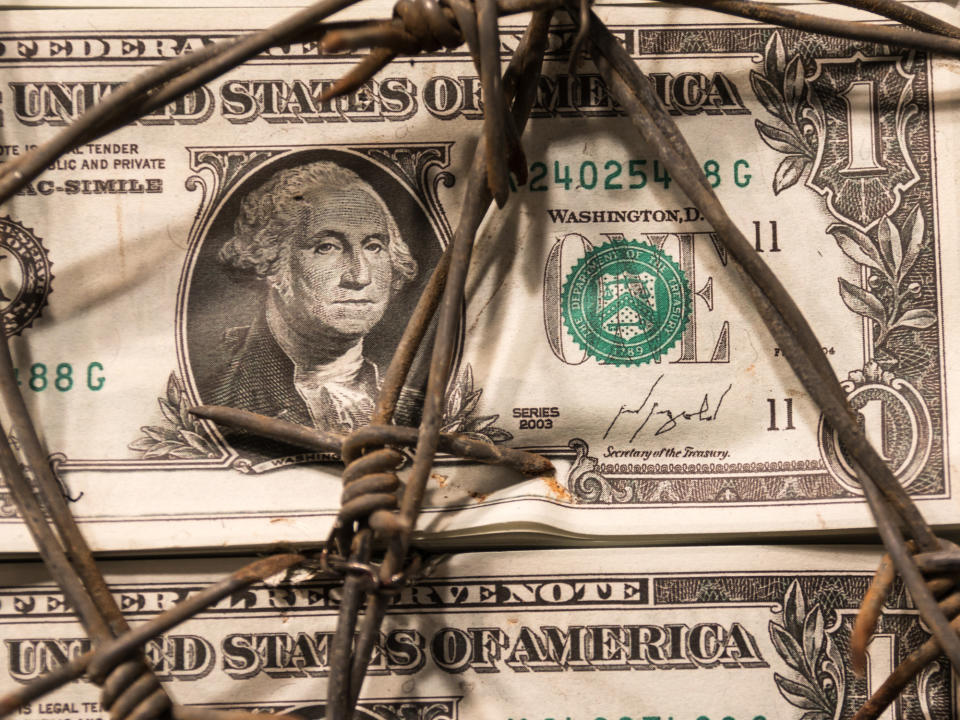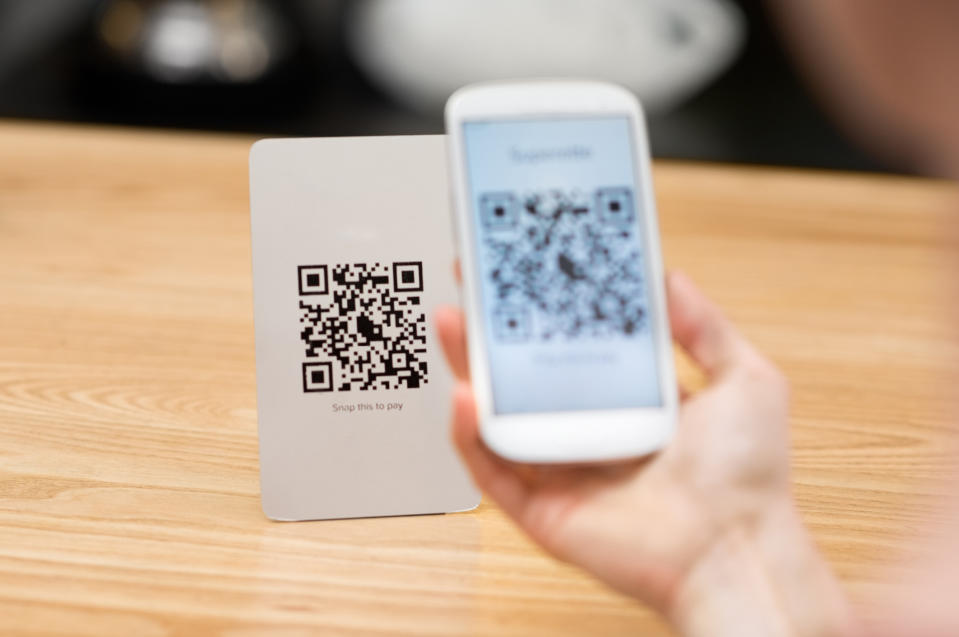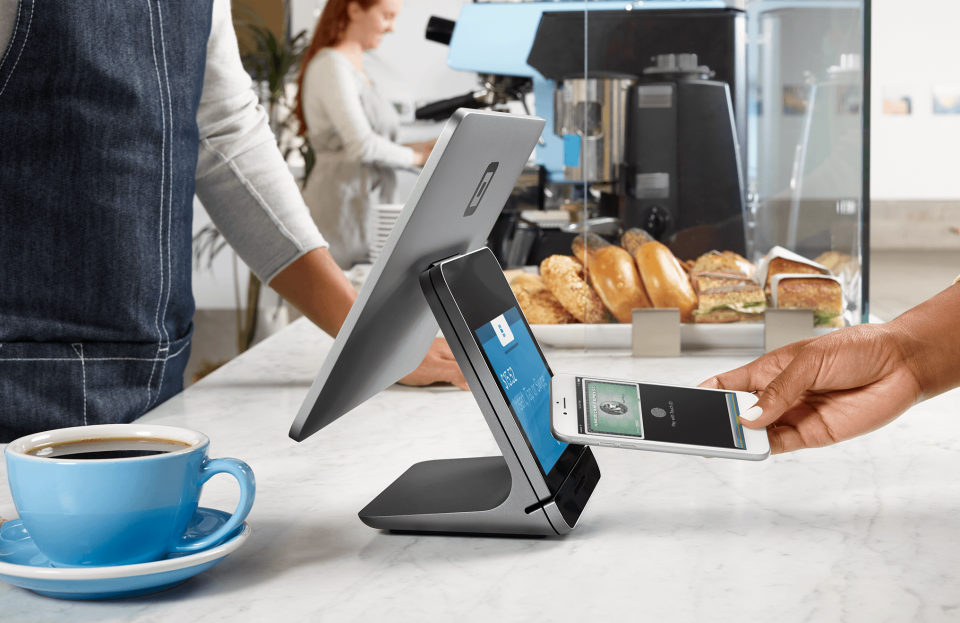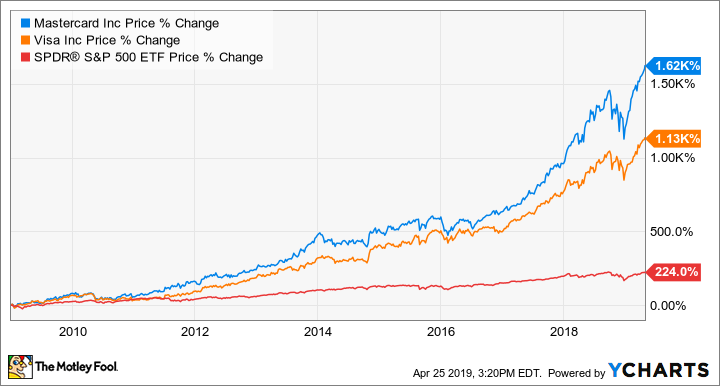Everything Investors Need to Know About the War on Cash
Physical forms of currency -- cash and personal checks -- are losing favor among global consumers to alternative forms of payment, including debit and credit cards, digital wallets, mobile commerce platforms, and, in some circles, even cryptocurrencies. Online banking applications and automatic bill-pay options are making writing checks, using cash for high-cost transactions, and other traditional financial services less and less attractive. While cash is far from nearing extinction and, surprisingly, is more robust in some places than one might first think, the overall trend seems almost undeniable when one considers the paradigm-shifting trends such as e-commerce and mobile payments at play.
So why is this happening? Will cashless societies exist in the future? How can investors take advantage of this trend? Which stocks stand to benefit from the war on cash? Will any companies become casualties?
We'll get to all of that, but first, let's look at where cash is today. Despite all the hype and a much-weakened hierarchical position in the global economy, cash remains a long way from being dead.

Is there a war on cash? Electronic and digital payments are on the rise around the globe for their more convenient and secure features. Image source: Getty Images.
How many people still use cash?
In 2013, Mastercard released a white paper claiming that 85% of the world's transactions were still being negotiated with physical currency, which equated to about 60% of the total retail transaction value. At Mastercard's 2017 Investor Day, CEO Ajay Banga stated that the number was still over 80% but was lower than it had been.
The British security company G4S released its World Cash Report in April 2019, surveying 47 different countries and 75% of the global population, according to the study. The report looked at a different metric, however: cash in circulation relative to GDP. Across the globe, the report stated that cash in circulation is now 9.6%, an increase from the 8.1% the same study found in 2011.
The PYMNTS.com March 2018 Global Cash Index stated:
Cash usage in the U.S. has largely held steady since 2003, despite an increasing number of digital payment methods. Usage has typically ranged from 14.2 to 15.1 percent of GDP, an exception being 2009, when the subprime mortgage crisis contributed to a sudden increase. The economy has since improved and cash share gradually declined, reaching 12.7 percent in 2016.
Of course, cash's place in a society varies greatly depending on where you look. In India, for instance, the cash share compared to the country's $3 trillion GDP was 49.3% in 2019. In Mexico, 90% of Mexican citizens preferred to use cash for transactions in 2018, and there were only 10 bank branches per 100,000 people. At the other end of the spectrum, nearly 60% of the transactions in Sweden were negotiated using payment methods other than cash, and cash made up only 2% of the total transaction value in the Scandinavian country.
As you can see, while still a long way from its heyday, cash still holds a prominent position in today's global economy.
Why is cash use declining?
Three catalysts are responsible for global commerce's gravitation toward cashless payments:
E-commerce
Mobile payments
International adoption of digital payments
Let's take a closer look at each of these key trends.
E-commerce

E-commerce grew 15.2% to $127.3 billion in the second quarter this year, according to the U.S. Census Bureau. Image source: Getty Images.
As platforms like PayPal took off and consumers got more comfortable trusting their credit card information to websites such as Amazon.com, e-commerce began to grow rapidly. And as e-commerce began to disrupt shopping patterns, credit cards and digital payments started to show similarly exponential growth. As Visa CFO Vasant Prabhu explained at the 2017 UBS Global Technology Conference, transcribed by S&P Global Market Intelligence, online purchases have been a huge boon for the credit card companies:
Simple numbers. E-commerce is growing 5x as fast as face-to-face transactions. And in an e-commerce transaction, the propensity to use a Visa card is twice as high as a face-to-face transaction. So something growing 5x as fast where your propensity to be used is twice what it might have been. That's phenomenal.
Mobile payments
In October 2014, Apple (NASDAQ: AAPL) launched Apple Pay, a digital wallet iPhone and Apple Watch owners could use to make payments at the point of sale, in-app, or online. The very next year, Samsung introduced Samsung Pay, a similar platform for Samsung smartphone and tablet owners. Lagging behind the two leading smartphone makers, in 2016, Alphabet (NASDAQ: GOOGL) (NASDAQ: GOOG) released Android Pay, since rebranded as Google Pay.
When looking at different mobile payment options, it is impossible to ignore the impact of PayPal (both its core platform and Venmo) and Square's Cash App. These platforms have gained traction because they are not tied to specific smartphone brands or operating systems, making it easier for each to establish a network effect. Digital payments were once thought of as competitors to industry incumbents, such as credit card networks and payment processing companies. But the industry's attitude began to change when PayPal made deals with credit card companies to cooperate, not compete.
Taken collectively, these digital wallets have met with mixed success, but consumer habits are changing. Mastercard's CFO Martina Hund-Mejean acknowledged that getting consumers to change their spending habits where an efficient payments system exists has always proven hard but says that the next generation will more easily adapt:
[W]herever you have an installed base of where payments actually work, it's hard to get people to be using a different form of payment. And that has been proven over the last 50 years as we ran our payment networks in many, many countries. But that is not to say that the United States is not going to go to mobile pay. ... Just watch how your kids are behaving and how they are using their phone, OK? So it will go. It will just take a little longer than in the number of other countries, where you didn't even have the installed base.
International adoption of digital payments

Technology such as QR codes has made it cheaper than ever for merchants in emerging countries to accept card and digital payments. Image source: Getty Images.
Hund-Mejean specified mobile payment adoption in the U.S. for a reason: It is taking off in other parts of the world. Due to the speed and near-universal coverage of wireless networks around the world, robust landline networks and expensive hardware are no longer required for merchants to accept card and digital payments. In fact, due to QR code technology, all that is needed is a smartphone for both the retailer and customer. QR codes are those black-and-white matrix images sometimes seen on packages and products in the U.S.
Visa's Prabhu explained how easy it was for merchants in emerging markets to set up shop and immediately begin using these codes to accept electronic and digital forms of payments:
In emerging markets and almost everywhere, if you wanted, all you need to do is print out a QR code on a piece of paper, stick it on your counter, download an app. Your consumer has an app. All you need is a cheap smartphone and you're an acceptor. That's just an example on how the cost of acceptance has gone from expensive to almost zero in terms of setting yourself up. And the speed with which you can do that has also gone up.
Other forms of mobile payments are sweeping across emerging countries. In Kenya and other countries, millions of people use M-Pesa, a mobile phone platform that can be used to pay bills and transfer money using text messages and PIN codes. Mastercard acquired Oltio, a payments start-up that uses a similar mobile-based solution as M-Pesa in South Africa.
In China, mobile payment platforms have exploded. As of late 2018, Tencent Holdings' (NASDAQOTH: TCEHY) WeChat Pay and Alibaba Group Holding Ltd's (NYSE: BABA) Alipay had 600 million and 400 million users, respectively . Warren Buffett's own Berkshire Hathaway invested in Paytm, a digital wallet platform in India that boasted 300 million active users at the time.
While they are taking different forms in different places, electronic and digital forms of payments are gaining traction as mobile network coverage increases. As this happens, the importance of cash to local economies, while still strong, is shrinking.
Cryptocurrencies, the latest alternative to cash
No conversation on the war on cash would be complete without discussing cryptocurrencies. While the history of bitcoin is long and mysterious, what investors need to know is that it is a virtual currency based on blockchain technology, a publicly distributed ledger that is updated in real time as each transaction is processed.
Before bitcoin's wild volatility captured the public's attention, it intrigued several believers who saw what they believed to be inherent advantages in blockchain-based currencies, including transparency, user anonymity, theoretically low transaction costs, and an existence outside of governmental control and interference. Of course, there are a number of disadvantages to cryptocurrency, too. Critics have pointed out that it still has a low rate of acceptance, its volatility makes it a poor choice as a means to store value, and bitcoin hacks and theft are still rampant.
Risks to investing in the war on cash
The primary risk to investing in this trend is probably obvious: While we have named the loser in this "war," it is much harder to know who the ultimate winner will be. Will card payments spread from the United States and other developed economies to emerging economies, or will mobile payments displace the plastic rectangles residing in our wallets? Are cryptocurrencies the future of money or a fad that will mostly be used for illicit purposes and black-market transactions?
These risks will affect different payments stocks differently, but it is probably smarter to invest in companies that appear likely to weather these storms. For instance, as mentioned above, no matter how consumers are paying electronically, they almost always use a Mastercard or Visa account number, whether an actual physical card is pulled out of a wallet or not. PayPal's mobile payment volume is now more than 40% of its total payment volume. Both Mastercard and Visa are already piloting programs using blockchain technology, the same tech that most cryptocurrencies are built on.
While nothing is ever guaranteed in investing, some companies definitely appear better able to outlast coming disruptions than others. Of course, this is also why I believe it is much better to invest in a basket of such securities than to limit yourself to just one or two stocks in this trend.
5 top stocks to profit from the war on cash
One of the most profitable things an investor can do is identify some of the best companies operating within a secular growth trend. With that in mind, I have identified five stocks that I believe will stand to benefit as the war on cash continues to play out across the globe in the coming years. These companies include credit card networks, digital wallet platforms, and payment processing companies. Let's take a closer look to determine why these companies make such good investments today.
Company Name | Type of Company |
|---|---|
Global Payments (NYSE: GPN) | Payment processing |
Mastercard (NYSE: MA) | Credit card network |
PayPal Holdings (NASDAQ: PYPL) | Digital payments platform |
Square (NYSE: SQ) | Payment processing |
Visa (NYSE: V) | Credit card network |
Data source: Google Finance.
Mastercard and Visa
Mastercard and Visa might benefit from the trend toward cashless commerce more than any other two companies. Both companies have a near-universal presence and make money with every transaction facilitated using their payment networks. This asset-light business model allows Mastercard and Visa to sport operating margins greater than 50% while the companies sit back and collect a steady stream of revenue as consumers make their purchases. Not a bad gig!
In the decade from 2009 to 2019, just a few years after Mastercard and Visa went public, their shares advanced well more than 1,000% while the S&P 500 appreciated just a little more than 200% in price. Their combined history of trouncing the market doesn't look to be ending any time soon.
Visa's truly massive scale gives it a global presence no other payment network can match. The company has issued billions of credit and debit cards that process trillions of dollars each quarter. Much of this growth is driven by Visa's international success, where its payment volume continues to rise by more than the company's overall growth rate. In a 2018 conference call, CEO Al Kelly said he expects the majority of the company's growth to continue to come from overseas markets:
[O]ver the next number of years, the bulk of our growth is going to come from overseas. It's something we're putting a lot of time and attention to. I've personally spent a lot of my personal time overseas. So, I think you're going to continue to see us invest in these markets. The cash displacement opportunity is great.
While not quite as large as Visa, Mastercard's scale still spans the globe. One of the keys to Mastercard's success has been the development of its "other revenues" category, which is its fastest-growing revenue segment. This revenue segment accounts for a variety of services Mastercard can bundle and offer its financial institutional clients, including data analytics, loyalty program management, and fraud prevention tools.
Over the past several years, Mastercard has made a series of acquisitions that have bolstered its capabilities in these arenas, so it can add real value to its banking partners. These services help Mastercard win new deals with other banks. Plus, the more these banks depend on Mastercard for such crucial services, the less likely they are to leave Mastercard for a rival when its contract expires. This dependence gives Mastercard "a much broader, wider relationship" with its customers, Banga said during a recent conference call.
PayPal
PayPal makes this list because it is almost uniquely positioned to benefit from mobile commerce, or m-commerce, in the United States. As CEO Dan Schulman put it in a recent conference call, transcribed by S&P Global Market Intelligence, PayPal is riding two huge trends: mobile technology and the war on cash.
[W]e believe our future opportunities are expansive and compelling. We are riding powerful and accelerating tailwinds created by 2 global trends, the digitization of cash and the mass adoption of mobile devices. We are actively positioning ourselves to take full advantage of these trends and strategically moving our business into areas where we believe these transformations are creating the strongest opportunities.
Payment volume originating from mobile devices exceeded 40% of PayPal's total payment volume as of early 2019. One Touch, PayPal's popular platform that simplifies online purchases, continues to grow as well, boasting over 100 million consumers and greater than 10 million merchants. This platform allows consumers to make online purchases with just the click of the button -- no entering lengthy credit card numbers and billing addresses required.
As of early 2019, PayPal had almost 300 million active user accounts that averaged using the platform more than three times per month. The large user size stems from PayPal's first-mover advantage -- it was the first digital wallet to speak of -- and gives it a real network effect advantage. The more users it gains, the more valuable its service becomes.
Global Payments
Global Payments makes the vast majority of its revenue through processing payments for vendors, taking a small cut of each sale so that merchants can accept card and digital payments at the point of sale (POS). So what makes it better than the average payment processing company? Global Payments has learned that it must offer more than simple payment processing services that can be easily commoditized. By creating robust ecosystems, Global Payments makes it hard for existing customers to leave and also gives new customers reasons to join.
For instance, in 2018, Global Payments bought AdvancedMD for $700 million to embed its payment processing capabilities in an established software vertical for a niche industry. AdvancedMD offers cloud-based back-office solutions designed to meet the needs of doctors' offices such as scheduling, billing, and payments. In 2017, the company acquired ACTIVE Network, a software platform for managing events, youth camps, and sports leagues, for about $1 billion, to accomplish the same thing. In between the acquisitions, it partnered with Aspira, a campground reservation software platform.
What do these have in common? They are all software platform verticals, allowing Global Payments to deepen its relationships with its customers, vastly reduce churn, and capture additional customers through the software sales channels. It's probably not a coincidence that they all exist in a fragmented market, creating a big opportunity for growth if they can capture additional market share.
Square
Like Global Payments, Square offers much more than an easily commoditized payment processing service. Square is creating a sticky ecosystem with the small-business customers it targets. Realizing that 85% of its payment volume originated from one of three industries -- restaurants, retail, and services -- it designed a specific POS system for each. For instance, Square for Restaurants is easy to set up and streamlines restaurants' back-office needs, seamlessly integrating the entire financial dashboard of a restaurant with its sales.

Square continues to develop a robust ecosystem by offering cloud-based back-office software platforms that its small-business customers find easy to use and helpful. Image source: Square.
Square's other extra services, those that smaller businesses often have a hard time affording or even having access to, are accounted for in Square's subscription- and services-based revenue. This category includes services such as Square Capital, its micro business loan platform; Caviar, a mobile order-ahead and delivery platform; and Instant Deposit, a feature that allows businesses and individuals to access their money instantaneously for a nominal fee. Once businesses are depending on Square for their payment processing, financing, and other features, they will find it difficult to leave for another payment processing vendor, even if the competitor is offering lower prices.
No peace treaty
The war on cash isn't going away any time soon. Consumers have spoken, and the security and convenience the digitization of money brings to financial transactions will continue to eat away at the market share of cash. Cash might never go extinct, but it will probably occupy decreasing market share in the world's economy for some time to come. As investors, it's important to recognize trends like this so that we can profit from them.
More From The Motley Fool
John Mackey, CEO of Whole Foods Market, an Amazon subsidiary, is a member of The Motley Fool's board of directors. Suzanne Frey, an executive at Alphabet, is a member of The Motley Fool's board of directors. Matthew Cochrane owns shares of Alibaba Group Holding Ltd., Alphabet (A shares), Amazon, Global Payments, Mastercard, PayPal Holdings, and Square. The Motley Fool owns shares of and recommends Alphabet (A shares), Alphabet (C shares), Amazon, Apple, Mastercard, PayPal Holdings, Square, Tencent Holdings, and Visa. The Motley Fool has the following options: long January 2020 $150 calls on Apple and short January 2020 $155 calls on Apple. The Motley Fool recommends eBay and PagSeguro Digital. The Motley Fool has a disclosure policy.

 Yahoo Finance
Yahoo Finance 
